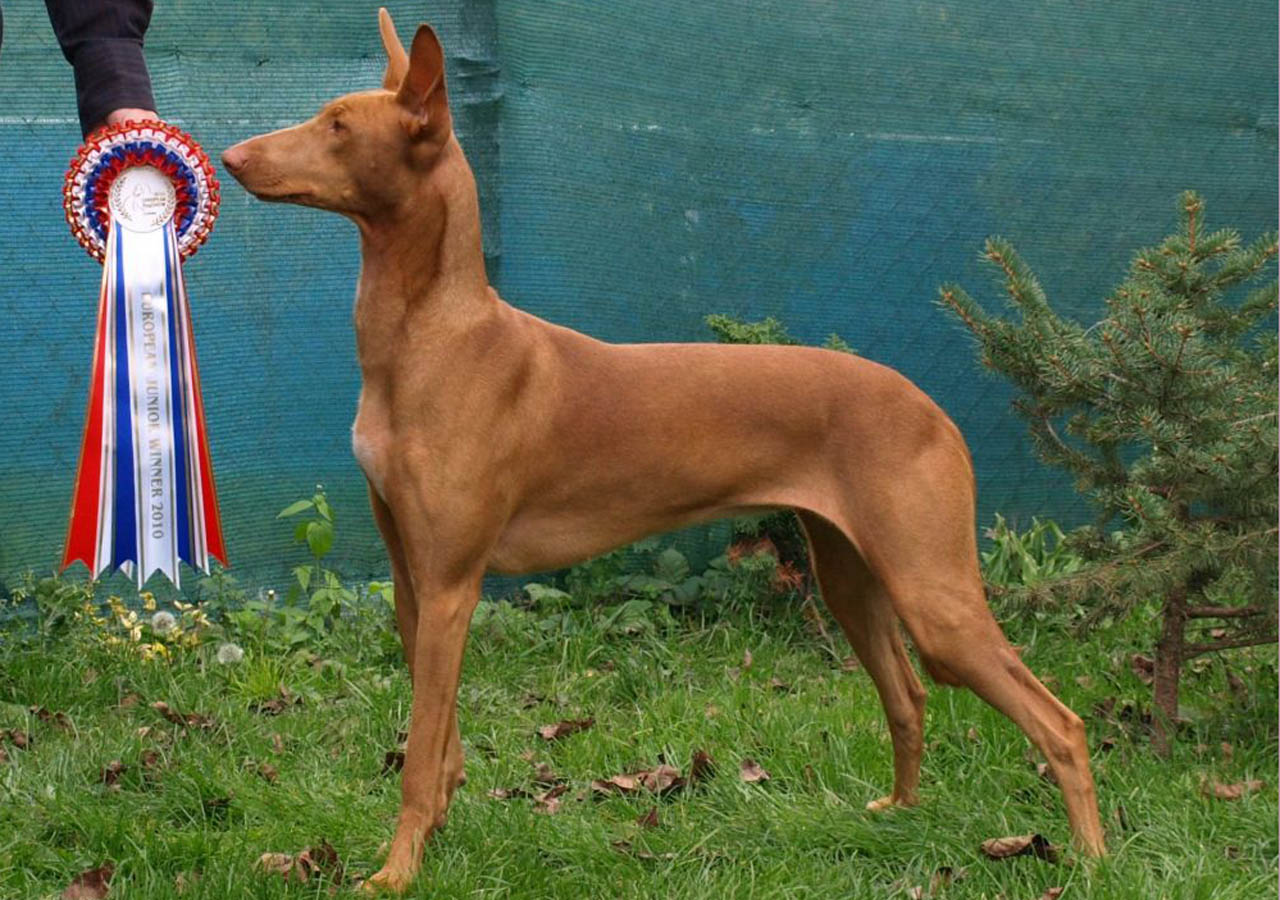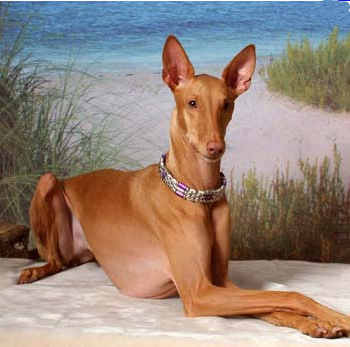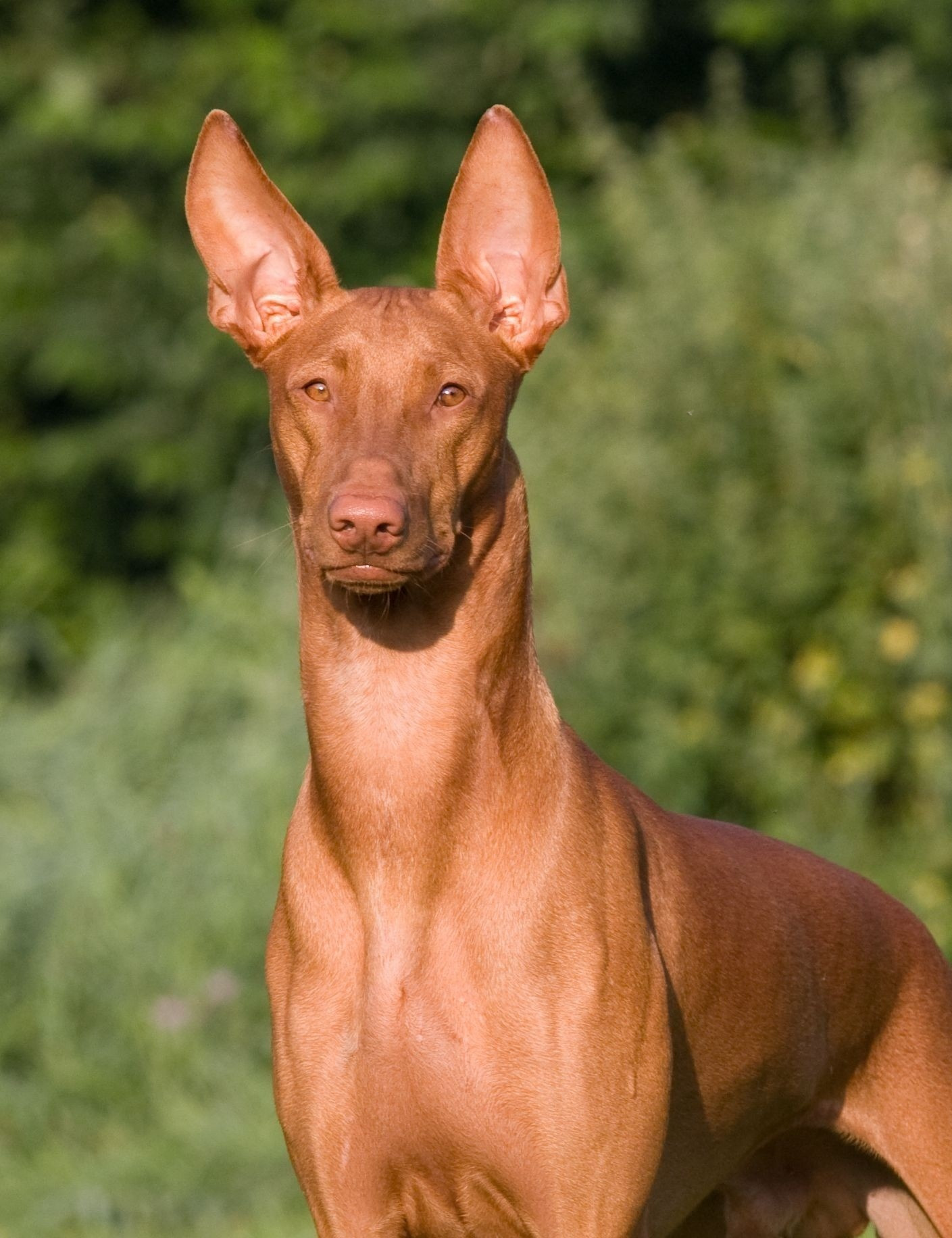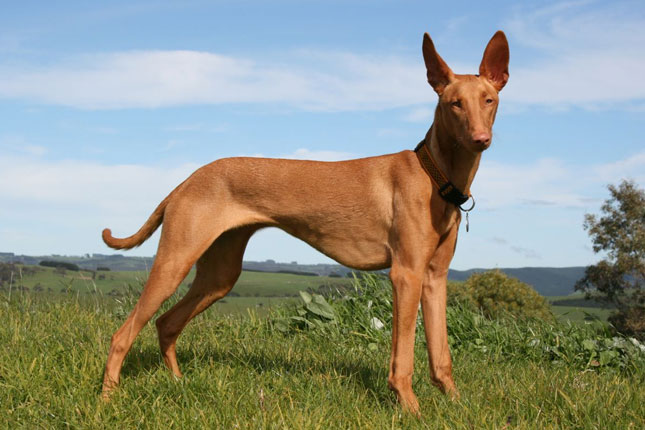
The Breed History
This breed is among the most ancient and mimics the depictions of
the Egyptian god, Anubis, the guide for the souls of the departed.
First records date back to around 3000 BC. Skeletal remains that
match Pharaoh hound body structure date back to about 5000 BC.
Paintings and many Egyptian hieroglyphs depict this dog. So highly
prized were these dogs that some were mummified along with the
nobility. Some of these dogs were exported to the Isle of Malta,
where they were carefully bred for over 2000 years. This rare breed
is the National Dog of Malta. It was not until 1983 that the AKC
registered the breed.
Breeding for Function
The historical record shows that this dog was used for hunting and
as a companion. In Malta, they were used specifically for hunting
rabbit. Their need for low food intake, agility, power, speed and
grace are traits that were valued and selected for. They can hunt
using scent and sight, plus sound. They have been successful in
obedience and coursing competitions.
Physical Characteristics
Height at Withers: female 21-24" (53-61 cm), male 23-25"
(58.5-63.5 cm)
Weight: 45-55 lb (20-25 kg)
Coat: Short glossy hairs lie flat and the hairs are hard in texture.
The coat is a rich red rust, tan or chestnut with limited white
markings. A white star on the chest (The Star) and a white tail tip
are especially acceptable.
Longevity: 12-14 years
Points of Conformation: These dogs are medium-sized with a
high head carriage. All of the body structures are lithe and finely
chiseled. There is an unusual breed trait called blushing. When very
excited, because the blood vessels are so superficial, their dilation
results in an increased rosy red flush affecting the ears and nose.
Another breed characteristic is the strong amber pigment of the
eyes. Palpebral margins, lip margins, and nose are all flesh colored.
Eyes are moderately deep and close set, and ears are medium-large
in size, set high and carried pricked high; leather is fine, and the
pinnae are very broad at the base. The skull is long and the stop
is minimal. The neck is long and muscular, with a small degree of
arching and no throatiness. The topline is level, except for a slight
slope down the croup. The tail is tapering and whip-like at the
terminus, reaching below the tarsus while at rest. The thorax is
deep, ribs are well sprung, and there is moderate tucking up of the
abdomen. Limbs are straight boned, and the feet are medium in size
with well knuckled up toes and strong large pads. Dewclaws fore
and hind may be removed. The gait is long striding and smooth,
and appears both powerful and effortless. When compared with the
Ibizan hound, the Pharaoh hounds are smaller, have less extreme
conformation and less white marking.
Recognized Behavior Issues and Traits
Reported breed characteristics include: Intelligent, easily trained,
friendly, and love children. They remain playful even as adults. They
need close human contact. Pharaoh hounds have low grooming
needs and don't get doggy odor even after becoming wet. They
are active dogs and without adequate exercise they become obese
easily. Not considered an apartment dog. They should be off leash
in a fenced enclosure only. They are not considered watch or guard
dogs, though they are aloof with strangers generally.
Normal Physiologic Variations
Sight hounds have lower normal ranges for T4 and T3
concentrations compared to other breeds.
Drug Sensitivities
Anesthesia: Sight hounds require particular attention during
anesthesia. Their lean body conformation with high surface-area-tovolume
ratio predisposes them to hypothermia during anesthesia.
Impaired biotransformation of drugs by the liver results in prolonged
recovery from barbiturate and thiobarbiturate intravenous
anesthetics. Propofol, and ketamine/diazepam combination are
recommended induction agents.
Inherited Disease
Hip Dysplasia: Polygenically inherited trait causing degenerative
joint disease and hip arthritis. OFA reports 2.4% affected.
Elbow Dysplasia: Polygenically inherited trait causing elbow
arthritis. OFA reports 1.5% affected.
Patella Luxation: Polygenically inherited laxity of patellar
ligaments, causing luxation, lameness, and later degenerative joint
disease. Treat surgically if causing clinical signs. Reported in the
breed, but too few Pharaoh Hounds have been screened by OFA to
determine an accurate frequency.
Disease Predispositions
Hypothyroidism: Inherited autoimmune thyroiditis. Reported as
a problem in the breed, but too few Pharaoh Hounds have been
screened for thyroid autoantibodies by Michigan State University to
determine an accurate frequency. (Ave. for all breeds is 7.5%).
Cataracts: Anterior or posterior intermediate and punctate
cataracts occur in the breed. Reported in the breed, but too few
Pharaoh Hounds have been CERF eye examined to determine
an accurate frequency. CERF does not recommend breeding any
Pharaoh Hound with a cataract.
Retinal Dysplasia: Retinal folds are recognized in the breed, but too
few Pharaoh Hounds have been CERF eye examined to determine an
accurate frequency.
Distichiasis: Abnormally placed eyelashes that irritate the cornea
and conjunctiva. Can cause secondary corneal ulceration. Reported
in the breed, but too few Pharaoh Hounds have been CERF eye
examined to determine an accurate frequency.
Persistent Pupillary Membranes: Strands of fetal remnant
connecting; iris to iris, cornea, lens, or involving sheets of tissue.
The later three forms can impair vision, and dogs affected with
these forms should not be bred. Reported in the breed, but too few
Pharaoh Hounds have been CERF eye examined to determine an
accurate frequency.
The Pharaoh Hound is a rare breed, and there is little documented
in the literature on health issues. Allergies, Demodicosis, Epilepsy,
and Gastric Dilitation-Volvulus are reported to occur in the breed.
Shoulder Luxation is reported.
Isolated Case Studies
Severe Zinc Responsive Dermatosis: Three of five puppies in a litter
of 3-month-old Pharaoh Hounds presented with severe generalized
erythematous-crusted papules, pruritus, footpad exfoliation,
inappetence, lethargy, and retarded growth. Histologically, there was
marked epidermal hyperplasia with a disorganized appearance of the
epidermis and massive parakeratotic hyperkeratosis. Low serum zinc
levels were documented, and the pups responded to intravenous,
but not oral zinc supplementation. The affected dogs received IV zinc
supplementation every three weeks to control their symptoms, but
all expired over a course of 3 years.
Genetic Tests
Tests of Genotype: None
Tests of Phenotype: CHIC Certification: Hip radiographs, thyroid
profile including autoantibodies, CERF eye examination, and patella
evaluation. (See CHIC website; www.caninehealthinfo.org).
Recommend elbow radiographs and cardiac examination.
Miscellaneous
- Breed name synonyms: Kelb-tal Fenek (means rabbit dog),
Pharoah Hound, Pharaoh.
- Registries: AKC, UKC, CKC, KCGB (Kennel Club of Great Britain)-P,
ANKC (Australian National Kennel Club), NKC (National Kennel Club).
- AKC rank (year 2008): 148 (72 dogs registered)
- Internet resources: Pharaoh Hound Club of America:
www.ph-club.org
The Pharaoh Hound Club (UK): www.pharaohhoundclub.co.uk
Photo Gallery of Breed - Pharaoh Hound - Dog Breed








 Animalia Life
Animalia Life